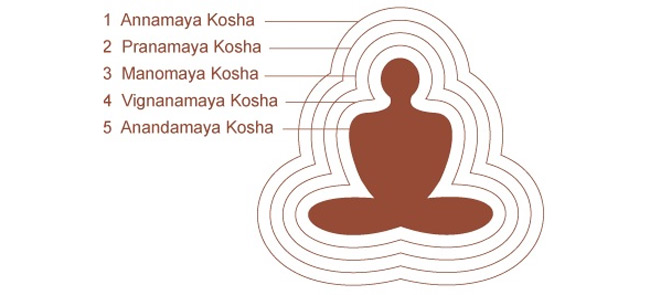
Anxiety disorder or Post Trumtic Stress Disorder (PTSD) can occur following experiences that are extremely frightening, threatening and traumatic. Intense feelings of fear, helplessness and horror are generally involved. While most trauma survivors exhibit short-term psychological reaction (acute stress disorder), some develop long-term, serious problems, showing that the body has failed to return to its pre-traumatic state.
From the yogic point of view, PTSD is a state of extreme disconnection. The body, mind and emotions are perceiving and functioning in a way that has no connection to the present. A stagnation of mind has occurred. Ongoing, inappropriate physiological, mental and emotional reactions cause havoc with the subtle energy system and in this muddle we move further from, rather than closer to, the harmony of body and mind which guides us towards integration and connection with spirit.
The yogic physiology of the koshas gives a useful basis for understanding the disintegration of personality inherent in PTSD. Each of the five koshas may be in a state of crisis.

Annamaya kosha
Annamaya kosha, the physical layer, is jagged with muscular tension and nervous and endocrinal system overload. A multitude of bodily ailments follow – digestive problems, arthritis, back and joint problems, hernia, recent surgery, tinnitus, and high blood pressure, as well as the expected psychological difficulties, including insomnia, headache, depression and anxiety.
For direct healing and support of annamaya, the yogic prescription of asana is simple, accessible and cheap. The effects are both immediate and cumulative. Relaxation is also an important practice for annamaya. The need to release deep muscular tension cannot be overstated for people with extreme and chronic tension.
Pranamaya kosha and the breath
Pranamaya kosha, the energy body, is intertwined with the breath at the physical level, the quality of breathing reflecting the state of the body, mind and emotions. In the person suffering from PTSD, pranamaya kosha is contracted. To contract the breath and prana brings suffocation of flow. The person’ s energy is unpredictable and has difficulty flowing with the river of life. The muscular tension blocks the nadis and restricts the breath. The mental and emotional tightness blocks the flow of knowledge and feeling into appropriate action, resulting in panic, anger, suppression, isolation, breakdown, insomnia or stress. The high state of arousal means unevenness and struggle in pranamaya kosha.
Asanas play a vital role in clearing blockages to the flow of prana in the body. To feel fresh, clear energy pulsing through the body and mind, that is the gift of asana to pranamaya kosha. Yoga nidra and simple pranayama are powerful tools for balancing, harmonising and managing energy. To be able to sleep without pills, without self-medicating on alcohol or marijuana, that is the gift of yoga nidra to pranamaya kosha. The vibration of Om chanting in meditation and the mantra and music of kirtan go directly to pranamaya kosha. They cleanse, they vitalise, and they harmonise.
Manomaya kosha
In the PTSD sufferer, manomaya kosha, the mental and emotional layer, is rife with insecurity, mood swings, fear, defensive reactions, confusion or despair. Of course, these feelings and thoughts are in constant interaction with annamaya and pranamaya. Because of this, the asanas and pranayamas also bring some peace to manomaya. But the most conscious work on manomaya involves direct mind management. Witnessing (which involves detachment), acceptance and letting go are key among these.
To feel difficult emotions successfully (i.e. without destructive reaction), the witnessing aspect must be cultivated. We are learning to reassess and re-create our identity, our self-image, the ‘I’ that we project onto all interactions: the basis of our perception of the world.
Meditation is generally recommended for harmonising and strengthening manomaya. For PTSD sufferers, many meditation techniques are out of reach. To watch the thoughts in antar mouna will be a huge challenge. To witness images in chidakasha invites flashbacks in a state of isolation. To simply sit still and close the eyes is a big task in the beginning. A wise approach to the benefits of meditation is to balance the internalisation with some sensory input. Trataka and Om chanting offer this type of reassurance. Meditation practices that are non-intellectual, simple and foster connection to reality will help heal the shattered manomaya of PTSD.
Vijnanamaya kosha
The next of the koshas is Vijnanamaya kosha. Vijnana means knowing. It is the sheath of wisdom that is underneath the processing, thinking aspect of mind. It knows, decides, judges, and discriminates between this and that, between useful and not useful. It is also the level of ego consciousness, meaning the powerful wave of I-am-ness. This I-am-ness itself is a positive influence, but when it gets co-mingled with the memories, and is clouded over by the manas, it loses its positive strength. With regular practice one can travel to this Kosha.
Anandamaya kosha
Anandamaya kosha is the most interior of the koshas, the first of the koshas surrounding the Atman, the eternal center of consciousness. Ananda means bliss. However, it is not bliss as a mere emotion experienced at the level of the sheath of mind. Ananda is a whole different order of reality from that of the mind. It is peace, joy, and love that is underneath, beyond the mind, independent of any reason or stimulus to cause a happy mental reaction. It is simply being, resting in bliss called ananda.
Yet, even this bliss, however wonderful it is, is still a covering, a sheath, a lampshade covering the pure light of consciousness. It is the subtle most of the five koshas. In the silence of deep meditation, this too is let go of, so as to experience the center.
One needs to understand that we can awaken our bliss sheath through three basic practices. The first is seva, selfless service. This opens our heart to our innate unity with other beings. The second is bhakti yoga, devotion to God. This opens our heart to our unity with the all-pervading Divine Being. The third is samadhi, intensely focused meditation, which opens our heart to our own divine being.